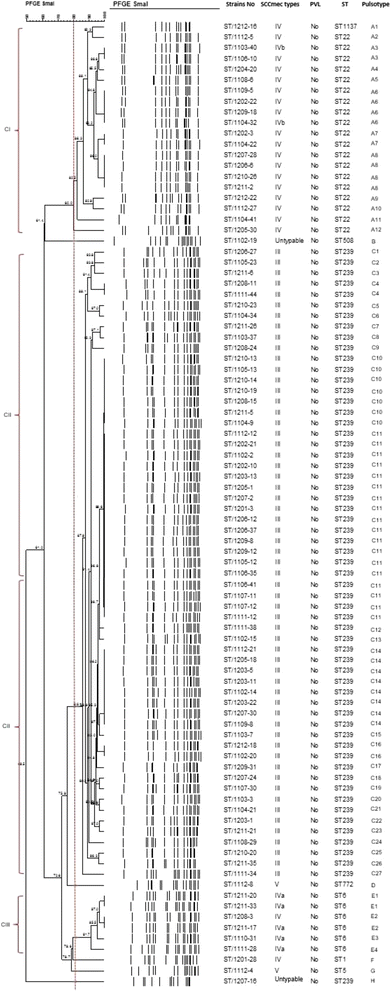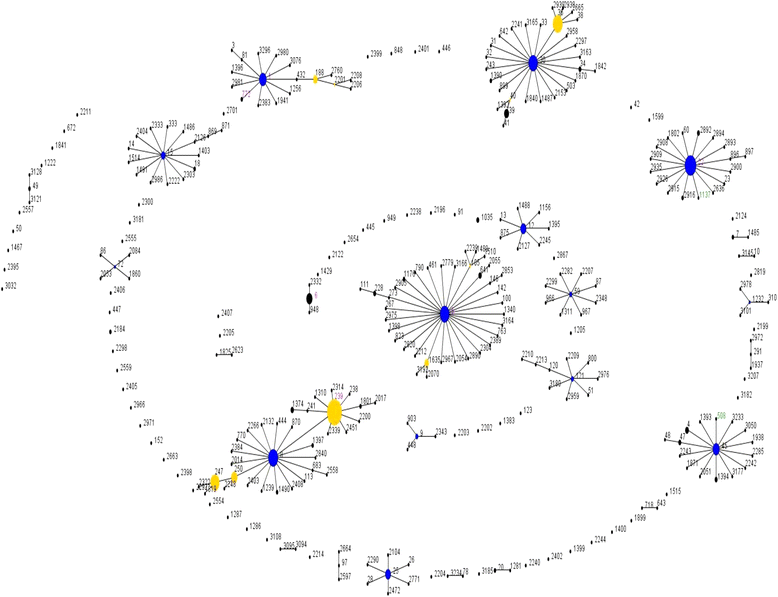Prevalence of methicillin-resistant Staphylococcus aureus (MRSA) infection and the molecular characteristics of MRSA bacteraemia over a two-year period in a tertiary teaching hospital in Malaysia
- PMID: 28407796
- PMCID: PMC5390426
- DOI: 10.1186/s12879-017-2384-y
Prevalence of methicillin-resistant Staphylococcus aureus (MRSA) infection and the molecular characteristics of MRSA bacteraemia over a two-year period in a tertiary teaching hospital in Malaysia
Abstract
Background: Methicillin-resistant Staphylococcus aureus (MRSA) is an established pathogen that causes hospital- and community-acquired infections worldwide. The prevalence rate of MRSA infections were reported to be the highest in Asia. As there is limited epidemiological study being done in Malaysia, this study aimed to determine the prevalence of MRSA infection and the molecular characteristics of MRSA bacteraemia.
Methods: Two hundred and nine MRSA strains from year 2011 to 2012 were collected from a tertiary teaching hospital in Malaysia. The strains were characterized by antimicrobial susceptibility testing, staphylococcal cassette chromosome mec (SCCmec) typing, detection of Panton-Valentine leukocidin (PVL) gene, multilocus sequence typing (MLST) and pulsed-field gel electrophoresis (PFGE). Patient's demographic and clinical data were collected and correlated with molecular data by statistical analysis.
Results: Male gender and patient >50 years of age (p < 0.0001) were significantly associated with the increased risk of MRSA acquisition. Fifty-nine percent of MRSA strains were HA-MRSA that carried SCCmec type II, III, IV and V while 31% were CA-MRSA strains with SCCmec III, IV and V. The prevalence of PVL gene among 2011 MRSA strains was 5.3% and no PVL gene was detected in 2012 MRSA strains. All of the strains were sensitive to vancomycin. However, vancomycin MIC creep phenomenon was demonstrated by the increased number of MRSA strains with MIC ≥1.5 μg/mL (p = 0.008) between 2011 and 2012. Skin disease (p = 0.034) and SCCmec type III (p = 0.0001) were found to be significantly associated with high vancomycin MIC. Forty-four percent of MRSA strains from blood, were further subtyped by MLST and PFGE. Most of the bacteraemia cases were primary bacteraemia and the common comorbidities were diabetes, hypertension and chronic kidney disease. The predominant pulsotype was pulsotype C exhibited by SCCmec III-ST239. This is a first study in Malaysia that reported the occurrence of MRSA clones such as SCCmec V-ST5, untypeable-ST508, SCCmec IV-ST1 and SCCmec IV-ST1137.
Conclusions: SCCmec type III remained predominant among the MRSA strains in this hospital. The occurrence of SCCmec IV and V among hospital strains and the presence of SCCmec III in CA-MRSA strains are increasing. MRSA strains causing bacteraemia over the two-year study period were found to be genetically diverse.
Keywords: MLST; MRSA Bacteraemia; Methicillin-resistant Staphylococcus aureus (MRSA); PFGE; SCCmec types.
Figures


Similar articles
-
Comparison of methicillin-resistant Staphylococcus aureus strains isolated in 2003 and 2008 with an emergence of multidrug resistant ST22: SCCmec IV clone in a tertiary hospital, Malaysia.J Microbiol Immunol Infect. 2013 Jun;46(3):224-33. doi: 10.1016/j.jmii.2013.02.001. Epub 2013 Mar 21. J Microbiol Immunol Infect. 2013. PMID: 23523045
-
Molecular epidemiology and characteristic of virulence gene of community-acquired and hospital-acquired methicillin-resistant Staphylococcus aureus isolates in Sun Yat-sen Memorial hospital, Guangzhou, Southern China.BMC Infect Dis. 2016 Jul 22;16:339. doi: 10.1186/s12879-016-1684-y. BMC Infect Dis. 2016. PMID: 27450316 Free PMC article.
-
Emergence of SCCmec type IV and SCCmec type V methicillin-resistant Staphylococcus aureus containing the Panton-Valentine leukocidin genes in a large academic teaching hospital in central Switzerland: external invaders or persisting circulators?J Clin Microbiol. 2010 Mar;48(3):720-7. doi: 10.1128/JCM.01890-09. Epub 2009 Dec 30. J Clin Microbiol. 2010. PMID: 20042625 Free PMC article.
-
The evolution of Staphylococcus aureus.Infect Genet Evol. 2008 Dec;8(6):747-63. doi: 10.1016/j.meegid.2008.07.007. Epub 2008 Jul 29. Infect Genet Evol. 2008. PMID: 18718557 Review.
-
The molecular evolution of hospital- and community-associated methicillin-resistant Staphylococcus aureus.Curr Mol Med. 2009 Mar;9(2):100-15. doi: 10.2174/156652409787581637. Curr Mol Med. 2009. PMID: 19275621 Review.
Cited by
-
Whole genome sequencing of methicillin-resistant Staphylococcus aureus clinical isolates from Terengganu, Malaysia, indicates the predominance of the EMRSA-15 (ST22-SCCmec IV) clone.Sci Rep. 2024 Feb 12;14(1):3485. doi: 10.1038/s41598-024-54182-x. Sci Rep. 2024. PMID: 38347106 Free PMC article.
-
Lead generation of UPPS inhibitors targeting MRSA: Using 3D-QSAR pharmacophore modeling, virtual screening, molecular docking, and molecular dynamic simulations.BMC Chem. 2024 Jan 20;18(1):14. doi: 10.1186/s13065-023-01110-1. BMC Chem. 2024. PMID: 38245752 Free PMC article.
-
Diversity of clonal complex 22 methicillin-resistant Staphylococcus aureus isolates in Kuwait hospitals.Front Microbiol. 2022 Aug 4;13:970924. doi: 10.3389/fmicb.2022.970924. eCollection 2022. Front Microbiol. 2022. PMID: 35992657 Free PMC article.
-
A Review on Antistaphylococcal Secondary Metabolites from Basidiomycetes.Molecules. 2020 Dec 11;25(24):5848. doi: 10.3390/molecules25245848. Molecules. 2020. PMID: 33322256 Free PMC article. Review.
-
Methicillin and inducible clindamycin resistance in clinical Staphylococcus aureus isolates: a cross-sectional study from Northwest Ethiopia.Front Microbiol. 2025 Jun 13;16:1569242. doi: 10.3389/fmicb.2025.1569242. eCollection 2025. Front Microbiol. 2025. PMID: 40584045 Free PMC article.
References
-
- Ahmad N, Ruzan IN, Abd Ghani MK, Hussin A, Nawi S, Aziz MN, Maning N, Eow VL. Characteristics of community- and hospital- acquired meticillin- resistant Staphylococcus aureus strains carrying SCCmec type IV isolated in Malaysia. J Med Microbiol. 2009;58(9):1213–1218. doi: 10.1099/jmm.0.011353-0. - DOI - PubMed
MeSH terms
LinkOut - more resources
Full Text Sources
Other Literature Sources
Medical
Research Materials

